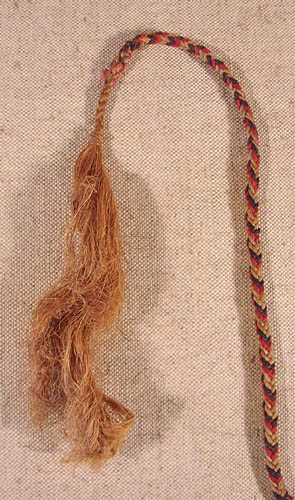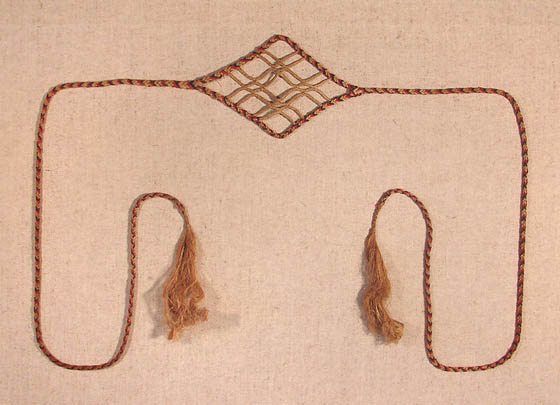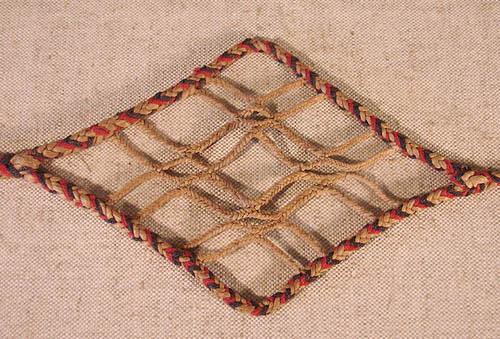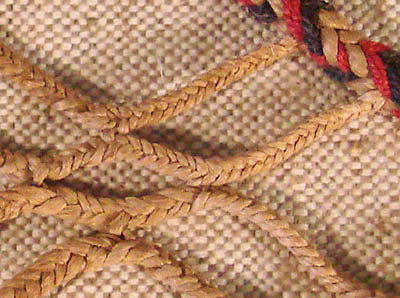| Artifacts - South America - stone, pottery, gold, textiles, beads | |
|
|
|
|
Pre-Columbian Textile Braided Sling / Tump Line #2 Inca Culture - Peru Classic Period 1100 to 1500 AD SOLD
dimensions: approx. 74" long including tassels tassels approx. 4 1/2" central cradle approx 4" wide x 6" long Braided camelid fiber sling or tump line with diamond shaped cradle. Tan natural fiber interwoven with natural dyed red and black fiber. Strand separates around cradle which is criss-crossed with smaller tightly braided cords forming a net or web, assumedly for holding a projectile. Sources differ in their description, but inclusion of both items was common in Inca burials. While the sling was used as a weapon, the tump line was used to steady heavy loads on mountain trails. Upon reflection, the item could be used for either purpose, and could also be used as a belt or for innumerable other purposes. Fabulous workmanship. Displayed in 28 1/2" x 20 1/2" acrylic display case with tan fabric backing board. |

|
|
Excellent Condition. Colors are vivid with minor fading from age. No significant wear. Lovely. |
|
|
|

|
|
|
|
|
"A sling is a projectile weapon typically used to throw a blunt projectile such as a stone. It is also known as the shepherd's sling. The sling is not to be confused with the slingshot, which works on completely different principles. A sling has a small cradle or pouch in the middle of two lengths of cord. The sling stone is placed in the pouch. Both cords are held in the hand, then the sling is swung and one of the two cords is released. This frees the projectile to fly in a straight line. It flies on a tangent to the circle that the pouch makes. The sling derives its effectiveness by essentially extending the length of a human arm, thus allowing stones to be thrown several times farther than they could be by hand. The sling is very inexpensive and easy to construct. It has historically been used for hunting game and combat. Today it still interests sportsmen as a survival tool and as an improvised weapon."
The sling was known throughout the Americas. In the ancient Andean civilizations such as the Inca Empire, slings were made from the wool of the llama. These slings typically have a cradle that is long and thin and features a relatively long slit. Andean slings were constructed from contrasting colors of wool; complex braids and fine workmanship result in beautiful patterns. Ceremonial slings were also made; these were large, non-functional and generally lacked a slit. To this day, ceremonial slings are used in parts of the Andes as accessories in dances and in mock battles.
The sling was used for hunting and warfare. One notable use was in Incan resistance against the conquistadors after the fall of the Incan Empire. These slings were apparently very powerful; in 1491: New Revelations of the Americas Before Colombus, historian Charles C. Mann quoted a conquistador, who said that an Incan sling "could break a sword in two pieces" and "kill a horse". quotes from Wikipedia
"There are two types of Inca slings. Ceremonial ones are oversize and elaborately decorated with geometric motifs, with long fringes. The other type is smaller and utilitarian, almost always with decoration only on the pouch and far ends. The decoration is geometric and the slings have fringed ends." quote from US Customs Service Guidelines |
|
|
for inquiries email info@galwest.com |
|
All pages on this web site are copyright 1998 to 2015 by Williams Gallery West


